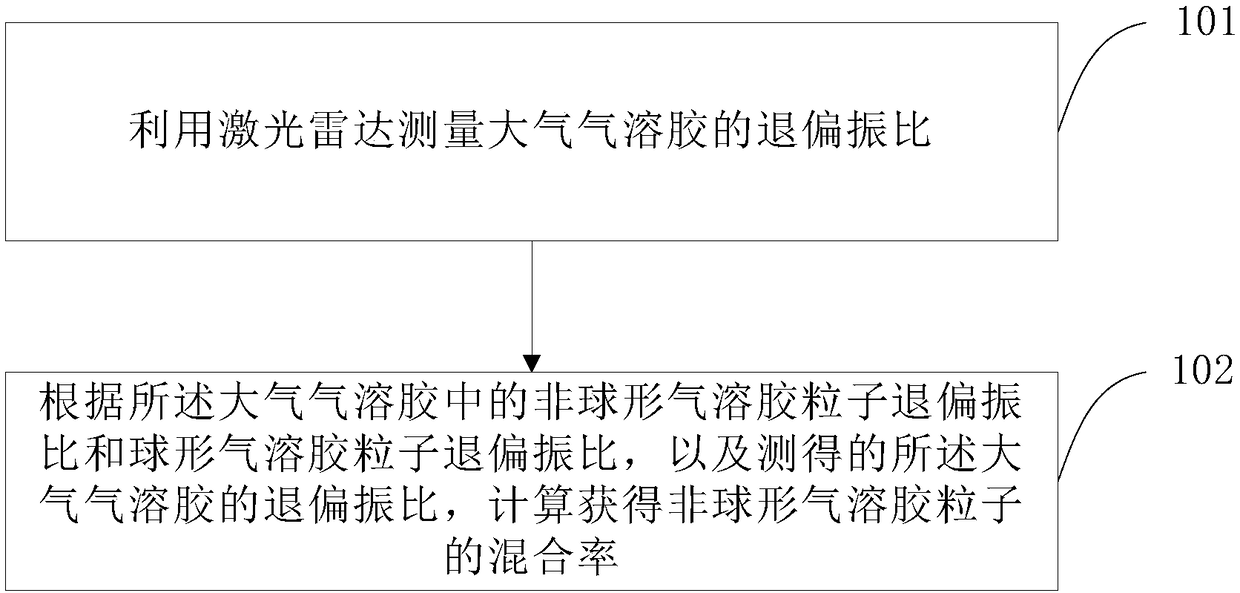A method and device for detecting the mixing rate of non-spherical aerosol particles
A detection method, aerosol technology, applied in the field of environmental detection, can solve the problem that the relative ratio and distinction between non-spherical aerosol particles and spherical aerosol particles cannot be quantitatively obtained
- Summary
- Abstract
- Description
- Claims
- Application Information
AI Technical Summary
Problems solved by technology
Method used
Image
Examples
Embodiment 1
[0018] figure 1 A schematic flow chart of the detection method for the mixing rate of non-spherical aerosol particles provided in Embodiment 1 of the present invention, as shown in figure 1 shown, including:
[0019] Step 101, using laser radar to measure the depolarization ratio of atmospheric aerosol.
[0020] Specifically, it can be measured by using a polarized rice scattering lidar, which emits a laser beam into the atmosphere, and the emitted laser beam is linearly polarized light, and the spherical aerosol particles of the laser beam and the aerosol particles in the atmosphere are in contact with the Non-spherical aerosol particles form scattered light, and the backscattered signal is received by the lidar. The depolarization of the backscattered light produced by spherical aerosol particles and non-spherical aerosol particles is different. The depolarization ratio of spherical aerosol particles is The non-spherical aerosol particles should be small, and the backscatt...
Embodiment 2
[0061] In order to further calculate the respective proportions of spherical aerosol particles and non-spherical aerosol particles in the atmospheric aerosol, the embodiment of the present invention determines the pollution type of the atmospheric aerosol according to the mixing rate of the aerosol particles in the previous embodiment After the step, it may further include: calculating the backscattering coefficient of the non-spherical aerosol particles in the atmospheric aerosol and the backscattering coefficient of the spherical aerosol particles through the mixing ratio of the non-spherical aerosol particles.
[0062] The backscattering coefficient of the spherical aerosol particles in the atmospheric aerosol is calculated according to the mixing ratio of the non-spherical aerosol particles. Specifically, the backscattering coefficient of spherical aerosol particles is calculated by the following formula:
[0063] beta nd =(1-R)β p ………………………………(14)
[0064] Among them, ...
Embodiment 3
[0076] The embodiment of the present invention also provides a detection device for the mixing rate of non-spherical aerosol particles, figure 2 A schematic structural view of the non-spherical aerosol particle mixing rate detection device provided in Embodiment 3 of the present invention, as shown in figure 2 As shown, it includes a measurement module 31 and a calculation module 32 connected in sequence.
[0077] The measurement module 31 is used to measure the depolarization ratio of atmospheric aerosol by using laser radar.
[0078] The calculation module 32 is used to calculate and obtain the depolarization ratio of the non-spherical aerosol particles and the depolarization ratio of the spherical aerosol particles in the atmospheric aerosol, as well as the measured depolarization ratio of the atmospheric aerosol. Mixing ratio of sol particles.
[0079] Wherein, the mixing ratio of non-spherical aerosol particles is used to indicate the proportion of non-spherical aeros...
PUM
 Login to View More
Login to View More Abstract
Description
Claims
Application Information
 Login to View More
Login to View More - R&D
- Intellectual Property
- Life Sciences
- Materials
- Tech Scout
- Unparalleled Data Quality
- Higher Quality Content
- 60% Fewer Hallucinations
Browse by: Latest US Patents, China's latest patents, Technical Efficacy Thesaurus, Application Domain, Technology Topic, Popular Technical Reports.
© 2025 PatSnap. All rights reserved.Legal|Privacy policy|Modern Slavery Act Transparency Statement|Sitemap|About US| Contact US: help@patsnap.com



